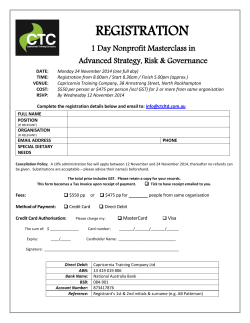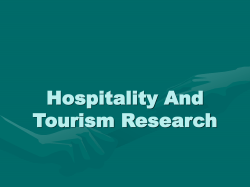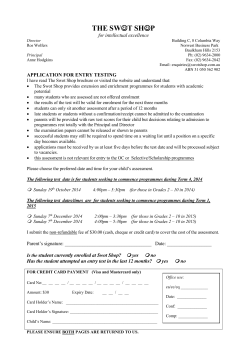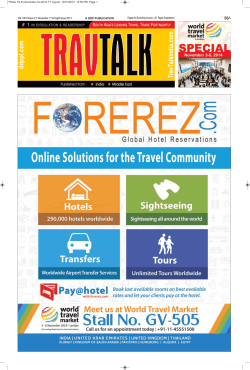
Strategy for Tourism Unit 6 The Internal
Strategy for Tourism Unit 6 The Internal Environment: Capability Reading Book Ch Tribe, J, (2010) Strategy for Tourism, Goodfellow Publishers, Oxford. 6 Capon, C. (2008) Understanding Strategic Management, Prentice Hall: Hemel Hempstead. 3 Tribe, J. (2005) The Economics of Recreation, Leisure and Tourism, Butterworth Heinemann, Oxford. - Johnson, G., Scholes, K., and Whittington, R. (2008) Exploring Corporate Strategy, Prentice Hall: Hemel Hempstead. 3 Learning Outcomes After studying this chapter and related materials you should be able to understand: resources and competences resource audit performance monitoring and control evaluation of products SWOT analysis and critically evaluate, explain and apply the above concepts. Case Study 6: InterContinental Hotels IHG only(IHG) owned 17 of its hotels in 2010. Group Its business model, which is increasingly typical in the hotel industry, is to concentrate on the management of hotels which are owned by other parties and on franchising its hotel brands. IHG manages 614 hotels but the largest part of its business is the 3,700 hotels that operate under franchise agreements. Its key capability is expertise in hotel management, operating systems, and marketing.. IHG measures success in three ways: Total shareholder returns. Rooms growth a basket of specific key performance indicators (KPIs) InterContinental Hotels Goa Resources and Competences Resources are the inputs that are used for the activities of tourism entities. Competences are the skills and abilities used to deploy resources to achieve a given end. Core competences are defined as those which are central to the entity’s mission and those which enable it to develop its competitive advantage. Resources may be classified under four headings: physical resources human resources financial resources, and intangibles Performance Monitoring and Control Specific techniques are often used for analysing the performance of human resources, and financial resources General techniques for analysis can include: value chain analysis balanced scorecard An organisation's performance with regard to resource utilisation can be given a useful perspective by way of comparative analysis Human Resources Monitoring of the performance of human resources is more complex than for other resources and involves qualitative as well as quantitative issues. Key issues for performance analysis include: Succession readiness Performance management Reward management Financial Resources For profit-making organisations financial indicators include: profit and loss share prices earnings per share price / earnings ratios return on capital employed profit margin revenue per available room revenue per available seat kilometre (RASK) efficiency liquidity Case Study: easyJet Image: © easyJet airline company limited. easyJet The following site includes some data on easyJet’s capability http://www.easyjet.com/common/img/easyjet_resu lts_YE_2007.pdf (The following link is for lecturers) easyjet_results_YE_2007.pdf Evaluate the performance of easyJet What other data might be useful? Value Chain The tendency to analyse organisations by reference to a narrow and visible aspect of its products resulted in analysts such as Porter (1985) developing the idea of the value chain. The product of a scheduled airline for example is not just a seat on an aeroplane, rather it is a complex set of connected activities that go to make up the total passenger experience - i.e. a value chain exists. For this part of resource analysis the purpose of examining the links in the value chain is to identify where cost savings may be made. Value Chain: Costs Element Activity Cost questions Preparation *Routes *Airports *Advertising *Information *Reservations *Sales *Are any routes unprofitable? *Can we use cheap, secondary airports? *Is advertising efficient? *Can reservation costs be cut? *Can IT reduce costs? *Charges for use of credit cards *Are commissions too high? Pre-Flight *Check-in *Baggage *Departure Lounge *Boarding *Can on-line check in be encouraged? *Can we charge for checked baggage? *Use cheap option if available *Stairs cheaper than walkways In Flight *Seat Choice *Seating *Flight Attendants *Meal *Entertainment *Other provision *Add as optional cost *Maximise seat numbers *Wages and commission schemes *Optional extra *Optional extra *Investigate other in flight revenues Post-flight *Baggage reclaim *Airport transfer *Reduce costs by charging for baggage Follow up *Customer requests *Customer complaints *Are passenger refund rules too generous? *Can we charge customers for telephone complaint lines using premium numbers? Hotel Premiere Classe Small rooms Out of town locations Compact bathrooms All help to cut costs in value chain Lufthansa Automatic check in cuts costs from the value chain Ryanair No Frills: Passengers pay extra for on-board catering on Ryanair Also note the advertising on the seat backs Balanced scorecard The balanced scorecard collects performance data from a range of an organisation’s activities. It arose from criticisms that other measures are too narrow Four areas that are typically targeted for review are: Financial perspective (e.g. profit margins, revenue growth, costs, cash flow, net operating income) Customer perspective (e.g., market share, customer satisfaction) Internal process perspective (e.g. asset utilization, supply chain management, customer management, innovation and relations with the external stakeholders), Innovation and learning perspective (e.g. human capital, information capital and organization capital). Comparative Analysis Comparative analysis can be made by reference to Longitudinal Analysis which uses an organisation's historical record to compare data on performance over time. Best Practice which uses data from other organisations in an industry to provide information on the highest performance standards attainable. Evaluation of Products Part of an organisation's capability review will focus on an evaluation of current products. There are several methods of analysis including: effectiveness value chain analysis portfolio analysis, and product life-cycle analysis. Effectiveness Effectiveness is a measure of how well a particular objective is achieved. Measures of product effectiveness may include: consumer satisfaction with product analysis of matching between product and market need performance of product comparison with competing products RATER RATER (Buttle, 1996) measures satisfaction in terms of: Reliability Assurance Tangibles Empathy Responsiveness. Value chain analysis Value chain analysis can also be used to determine whether improvements or value-added can be incorporated into a product's value chain. Example is a health spa in a 5* Sofitel hotel Portfolio analysis Portfolio analysis considers whether an organisation's range of products are well balanced with a particular view to the future. The Boston Consulting Group (BCG) matrix which considers products in terms of their market share and market growth may be used to assess the balance of an organisation's portfolio of products. BCG Matrix Product life-cycle analysis Product life cycle (PLC) (Vernon, 1966, 1979) analysis is useful in considering the future path of sales of a product. The next slides depicts the four main stages of Introduction Growth Maturity and Decline and the characteristics of these stages are tabulated. Clearly products which are entering decline may need rejuvenation or replacement whereas market development may be appropriate for those in the growth phase. Product life-cycle analysis Product Life Cycle Introduction Growth Maturity Decline Ignorance of product Scepticism of product More awareness of product Growing demand Mass market Seeking new products Repeat customers Competition None or little Growing Consumer choice Market saturated Products Changing standards and design Quality unproven Quality improves High reliability Standardisation Overtaken by new products Production High costs Mass production Low production and economies of costs scale Over capacity Marketing High advertising High prices Marketing economies Reduce price Customers Segmentation Competitive strategy vital Reduce price Seek to re-launch Butler’s TDLC Model Butler (1980) applied the PLC model to destinations, substituting number of visitors for sales on the vertical axis. The stages identified in the destination life cycle were first exploration, characterised by a few initial visitors, followed by involvement where some facilities are developed. Development involves perhaps more external investment and more sophisticated and comprehensive facilities. A consolidation and stagnation phase represent a destinations journey into maturity where tourism has become a major local industry. Butler suggests that this may be followed by decline, reduced growth, stabilisation or rejuvenation, according to the policy chosen. Butler’s TDLC Model Criticisms of TDLC analysis are summarised by Witt, Brooke and Buckley (1995) and include the lack of empirical validation for its shape, and the determinism implied by the cycle (i.e. that maturity and decline are unavoidable). When applied to destination it is asked whether this is an appropriate level of aggregation since different geographical zones and market segments within a destination may reflect different stages of development. There is also evidence that the length of the PLC is shortening. SWOT Analysis SWOT analysis is an executive summary of the different elements of strategic analysis. Under SWOT, the detailed analysis of an organisation's external environmental and internal resource position is distilled and summarised into key factors. Once the key SWOT elements have been identified, it can be productive to prepare a grid with strengths and weaknesses and opportunities and threats. Identification of an organisation's situational position by means of a SWOT analysis is an important phase in prior to consideration of strategic options which is the subject of the next chapter. Appropriate strategies are likely to: align opportunities and strengths transform weaknesses, and overcome threats SWOT Analysis Internal (Capability) Analysis •Resources Strengths Weaknesses Opportunities Threats •Products External (Environment) Analysis •Competition •Political •Economic •Socio-cultural •Technological Review of Key Terms Resources: Physical resources, human resources, financial resources, and intangibles Value Chain: Set of connected activities that make up the total service provision Balanced Scorecard: Performance data from a range of an organisation’s activities. Longitudinal Analysis: Uses an organisation's historical record to compare data on performance over time. Best practice: Uses data from other organisations in an industry to provide information on the highest performance standards attainable Portfolio Analysis: Evaluates an organisation's range of products in terms of their market share and market growth Product Life Cycle: Depicts the four main stages of development as introduction, growth, maturity and decline Tourism Area Life Cycle: Exploration, involvement, development, consolidation and stagnation SWOT analysis: Stands for Strengths, Weaknesses, Opportunities and Threats Discussion Questions 1. Use the RATER (Buttle, 1996) elements of: Reliability Assurance Tangibles Empathy Responsiveness to carry out a quality audit on a named tourism service. Identify any service gaps and make recommendations. 2. What is value chain analysis? Conduct a value chain analysis for a hotel which focuses on ways of either reducing costs or improving service. 3. Identify the position on a Boston Box of the main products of a named tourism organisation. What conclusions can you reach about the balance of the portfolio of products and what points for future planning emerge from this exercise? 4. To what extent can the concept of product life cycles be used to analyse destinations (Butler, 1980)? 5. What is the purpose of a SWOT analysis? Conduct a SWOT analysis for a tourism entity. United Airlines Link to United Airlines Investor’s Day Presentation Case Study: DCMS The Capability Review of the Department for Culture, Media and Sport can be found at http://www.civilservice.gov.uk/documents/capability/pdf/Cap ability_Review_DCMS.pdf What is the link between tourism and the DCMS? What does capability mean? What is the purpose of such a report? How capable is the DCMS? Could the method of this report be used for other tourism organisations? See esp p15 Strategy Strategyfor forTourism Tourism Unit 6 The Internal Environment: Capability The End
© Copyright 2025














